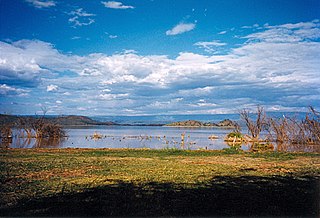
Lake Baringo is, after Lake Turkana, the most northern of the Kenyan Rift Valley lakes, with a surface area of 130 square kilometres (50 sq mi) and an elevation of 970 metres (3,180 ft). The lake is fed by several rivers, Molo, Perkerra and Ol Arabel, and has no obvious outlet; the waters are assumed to seep through lake sediments into the faulted volcanic bedrock. It is one of the two freshwater lakes in the Rift Valley in Kenya, the other being Lake Naivasha. In a remote location in a hot and dusty area with over 470 species of birds, occasionally including migrating flamingos. A Goliath heronry is located on a rocky islet in the lake known as Gibraltar.
dorobo is a derogatory umbrella term for several unrelated hunter-gatherer groups of Kenya and Tanzania. They comprised client groups to the Maasai and did not practice cattle pastoralism.
Sam, SAM or variants may refer to:

Isiolo is a town in Isiolo County, of which it is the capital. It is located in the middle of Kenya, and lies 285 kilometres north of the capital Nairobi. The town grew around the local military camps, much of the population being descended from former Somali soldiers who had fought in World War I as well as other Cushitic-speaking pastoral communities and the Ameru community. The town has an estimated population of 80,000 people, most of them living in the rural outbacks of the District. There is an increasing urban population in the recent years, especially from as far as Moyale, Marsabit and Mandera. The Isiolo town is also becoming a centre of interest because of its newly acquired status as a resort city cashing in on the popular Samburu and Shaba Game reserves, which have become preferred destinations after the famed Maasai Mara. Isiolo lies along the long A2 Road, leading towards Marsabit and Moyale much farther north.
Waaq is the name of God in the traditional religion of many Cushitic people in the Horn of Africa.
The Rendille are a Cushitic-speaking ethnic group inhabiting the northern Eastern Province of Kenya.

Kenya is a multilingual country. The Bantu Swahili language and English, the latter being inherited from colonial rule, are widely spoken as lingua franca. They serve as the two official working languages. Including second-language speakers, there are more speakers of Swahili than English in Kenya.

Ashanti to Zulu: African Traditions is a 1976 children's book written by Margaret Musgrove and illustrated by Leo and Diane Dillon. It was Musgrove's first book, but the Dillons were experienced artists and this book won them the second of their two consecutive Caldecott Medals.
The Sakuye or Saguye are a semi-nomadic Oromo people living in Marsabit and Isiolo Counties, Eastern Province, Kenya.
Arbore is an Afro-Asiatic language spoken by the Arbore people in southern Ethiopia in a few settlements of Hamer woreda near Lake Chew Bahir.
Baiso is an Afro-Asiatic language spoken in Ethiopia, in the region around Lake Abaya. It is an unwritten language.
The Rendille–Boni languages is a proposed subgroup of the Macro-Somali languages, belonging to the Cushitic family. The languages are spoken in Kenya. The hypothesis has been by now rejected, in favor of grouping Aweer as a member of the Somali languages, closely related to Garre.
Rendille is an Afro-Asiatic language spoken by the Rendille people inhabiting northern Kenya. It is part of the family's Cushitic branch.
The Ariaal are northern Kenyan pastoralists. They claim descent from cattle-owning Samburu who captured significant herds of camels and learned how to manage them from their eastern neighbours, the Rendille. This led them to adopt the Rendille culture, language, and other Rendille practices, such as monogamy. Before Kenya independence, the separation between the cattle and camel economies was vividly reflected in the division between an Ariaal elder’s senior wife, whose family would be reared as Ariaal, and his junior wives who lived with his cattle as Samburu. In effect, such elders continued to straddle the boundary between monogamous camel-owning Ariaal and polygynous cattle-owning Samburu, speaking both languages and participating in both cultures.
The Omo–Tana languages are a disputed branch of the Cushitic family and are spoken in Ethiopia, Djibouti, Somalia, and Kenya. The largest member is Somali. There is some debate as to whether the Omo–Tana languages form a single group, or whether they are individual branches of Lowland East Cushitic. Blench (2006) restricts the name to the Western Omo–Tana languages, and calls the others Macro-Somali.

Laisamis Constituency is an electoral constituency in Kenya. It is one of four constituencies in Marsabit County. The entire constituency is located within Marsabit County Council area. The constituency was established for the 1988 elections. Formally known as Marsabit South, it was represented by Hon. Phillip Kurungu in the 1966 elections. From 1969-1988 Laisamis Constituency was represented by Hon. Haji Kholkhale Adichareh. Hon. Adichareh was a Lancaster House Conference delegate and was a fierce defender of Rendille land. He served 7 years at Shimo La Tewa prison on trumped up charges and emerge to lead his Rendille community for 20 years in parliament.
Jacqueline Roumeguère-Eberhardt was a French anthropologist, research director at the French National Centre for Scientific Research (CNRS) and Africa specialist. She conducted pioneering research in Southern Africa, Central and Kenya, which led her to develop the project "Totemic Geography of Africa "(TGA). During her career, she has collected valuable fieldwork material which now constitute a substantial archive. She is the author of numerous scientific publications in French and English.
Worr Libin was an alliance of Cushitic-speaking population groups that inhabited various regions of northern Kenya and southern Ethiopia. It has been argued that the adoption of the Borana language by the other Somaloid Worr Libin groups reflected their acceptance of a regional Boran political hegemony. This period is thought to have lasted from 1550-1920.
The Burkineji were a pastoral community who inhabited regions of northern Kenya through to the late 19th century. The present day Samburu consider themselves a descendant community of the Burkineji.




